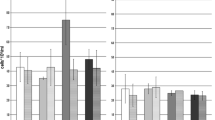Abstract
A moderately thermophilic mixed culture, MT, and the thermophilic Sulfolobus acidocaldarius strain BC were studied for their response to arsenic in a defined medium and also in media containing a pyrite and an arsenical pyrite flotation concentrate. In defined medium, the individual constituents of the MT culture exhibited a high tolerance to arsenite and arsenate compared to S. acidocaldarius strain BC. When grown on increasing concentrations of the pyrite flotation concentrate, both cultures had similar specific leaching rates over the various concentrations of the mineral substrate. In contrast, S. acidocaldarius strain BC exhibited a decreasing specific leaching rate when grown on the arsenical pyrite while the MT culture was not affected. In addition, arsenic added to cultures of S. acidocaldarius strain BC growing with pyrite as a growth substrate inhibited further growth, while added arsenic had no effect on the MT culture growing on the pyrite. These data indicate that the moderately thermophilic, arsenic-resistant MT culture was able to leach arsenical pyrite more efficiently than was the S. acidocaldarius strain BC culture at high concentrations of the mineral. This emphasizes the fact that proper culture selection is an important parameter when developing commercial processes involving arsenic-containing minerals.
Similar content being viewed by others
References
Amaro AM, Hallberg KB, Lindström EB, Jerez CA (1994) An immunological assay for detection and enumeration of thermophilic biomining microorganisms. Appl Environ Microbiol 60: 3470–3473
Barrett J, Ewart DK, Hughes MN, Nobar AM, Poole RK (1990) The oxidation of arsenic in arsenopyrite: the toxicity of As(IIl) to a moderately thermophilic mixed culture. In: Salley J, McCready RGL, Wichlacz PL (eds) Biohydrometallurgy. Canada Centre for Mineral and Energy Technology, Ottawa, Ontario, pp 49–57
Budden JR, Spencer PA (1993) Tolerance to temperature and water quality for bacterial oxidation: the benefits of Bactech’s moderately thermophilic mixed culture. FEMS Microbiol Rev 11: 191–196
Carlson L, Lindström EB, Hallberg KB, Tuovinen OH (1992) Solidphase products of bacterial oxidation of arsenical pyrite. Appl Environ Microbiol 58: 1046–1049
Collinet M-N, Morin D (1990) Characterization of arsenopyrite oxidizing Thiobacillus. Tolerance to arsenite, arsenate, ferrous and ferric iron. Antonie Van Leeuwenhoek J Microbiol 57: 237–244
Hallberg KB, Lindström EB (1994) Characterization of Thiobacillus caldus, sp. nov., a moderately thermophilic acidophile. Microbiology 140: 3451–3456
Lawrence RW (1990) Biotreatment of gold ores. In: Ehrlich HL, Brierley CL (eds) Microbial mineral recovery. McGraw-Hill, New York, pp 127–148
Lindström EB, Gunneriusson L (1990) Thermophilic bioleaching of arsenopyrite using Sulfolobus and a semi-continuous laboratory procedure. J Ind Microbiol 5: 375–382
Lindström EB, Sehlin HM (1989) Toxicity of arsenic compounds to the sulfur-dependent archaebacterium Sulfolobus. In: Salley J, McCready RGL, Wichlacz PL (eds) Biohydrometallurgy 1989. Canada Centre for Mineral and Energy Technology, Ottawa, Ontario, pp 59–70
Lindström EB, Gunneriusson E, Tuovinen OH (1992) Bacterial oxidation of refractory sulfide ores for gold recovery. Crit Rev Biotechnol 12: 133–155
Lindström EB, Wold S, Ketteneh-Wold N, Sääf S (1993) Optimization of pyrite bioleaching using Sulfolobus acidocaldarius. Appl Microbiol Biotechnol 38: 702–707
Ngubane WT, Baecker AAW (1990) Oxidation of gold-bearing pyrite and arsenopyrite by Sulfolobus acidocaldarius and Sulfolobus BC in airlift reactors. Biorecovery 1: 255–269
Sehlin HM, Lindström EB (1992) Oxidation and reduction of arsenic by Sulfolobus acidocaldarius strain BC. FEMS Microbiol Lett 93: 87–92
Silverman MP, Lundgren DG (1959) Studies on the chemoautotrophic iron bacterium Ferrobacillus ferrooxidans. I. An improved medium and harvesting procedure for securing high yields. J Bacteriol 77: 642–647
Willsky GR, Malamy MH (1980) Effect of arsenate on inorganic phosphate transport in Escherichia coli. J Bacteriol 144: 366–374
Author information
Authors and Affiliations
Corresponding author
Rights and permissions
About this article
Cite this article
Hallberg, K.B., Sehlin, H.M. & Lindström, E.B. Toxicity of arsenic during high temperature bioleaching of gold-bearing arsenical pyrite. Appl Microbiol Biotechnol 45, 212–216 (1996). https://doi.org/10.1007/s002530050672
Received:
Revised:
Accepted:
Issue Date:
DOI: https://doi.org/10.1007/s002530050672




